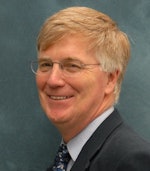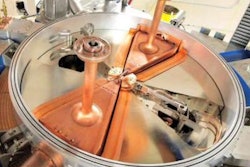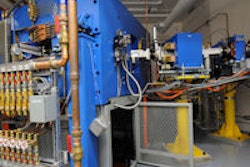
The Canadian government has awarded a $3 million ($2.9 million U.S.) grant to the University of Alberta in Edmonton and the University of Sherbrooke in Quebec to develop a new type of cyclotron that can produce technetium-99m -- helping alleviate the shortage of medical isotopes in North America.
So far, early diagnostic tests have found the cyclotron-produced technetium to be equivalent to the medical isotopes derived from nuclear reactors, such as the National Research Universal reactor operated by Atomic Energy of Canada (AECL) at Chalk River, Ontario.
 |
| Dr. Alexander McEwan from the University of Alberta's Cross Cancer Institute. Image courtesy of SNM. |
"We have been looking at this as a theoretical approach to making technetium for a year," McEwan said. "The physicists tell us that the best energy is 24 MeV and that we need to run [the cyclotron] at 400 to 600 µA to be able to get the yields that you would want for routine clinical use on a daily basis. The research question that we have to answer first is: If you build a 24-MeV cyclotron, can you run targets at that current? That's what we have the grant to do."
'Big leap'
McEwan described the venture as "a big leap in targets, and it will be a big leap in extraction" of technetium. The construction of the 24-MeV cyclotron itself "is not a massive, difficult project," he added, because Advanced Cyclotron Systems has built 30-MeV and 19-MeV cyclotrons in the past.
"The issue is the construction of the target and robustness of the target," McEwan said. "Once we have proven extraction, we have to prove we can manufacture it on a daily basis."
If and when researchers definitively prove technetium can be manufactured with the 24-MeV cyclotron, they will focus on extracting the technetium to radiolabel routine radiopharmaceuticals. They also plan to apply for another grant once that phase is under way.
'Evolutionary path'
"What we would be most interested in is whether we can replace the technetium supply by this method, but it also is an effective machine for manufacturing iodine-123 and iodine-124," McEwan said. "The project provides an evolutionary path in PET radiopharmaceuticals."
Researchers expect to have the cyclotron built and operating within nine to 12 months, if all regulatory approvals are achieved, with phase I of the demonstration project completed one year afterward. "Then we would start the extraction experiments about two-thirds of the way through that year," McEwan added.
McEwan is the former president of SNM of Reston, VA, and was named as a special advisor on medical isotopes to the Canadian health minister in June 2009. Over the past 10 months, he has spoken several times before House of Commons committees on the shortage of medical isotopes in Canada.
Despite the tightening of technetium supplies, the nuclear medicine community has "coped better than we feared," McEwan said. "People have learned to use their generators more efficiently, coupled with the broadening of the supply [and] technologists working their butts off to change appointments and work odd hours to ensure the use of generators when they have maximum activity."
McEwan said his concern is how much longer people can cope. "People are finding themselves stressed. There are reports of reduced referrals and increased costs with people working overtime and on weekends" to accommodate and match patient scans with isotope availability.
By Wayne Forrest
AuntMinnie.com staff writer
April 9, 2010
Related Reading
Canada makes investment in isotope production, April 1, 2010
Covidien warns of 'extreme' Mo-99 shortage in May, March 30, 2010
AECL delays NRU restart to late July, March 26, 2010
SNM warns of 'significant disruptions' in Mo-99 supply, March 22, 2010
FDA, Health Canada approve Polish moly, March 11, 2010
Copyright © 2010 AuntMinnie.com




















